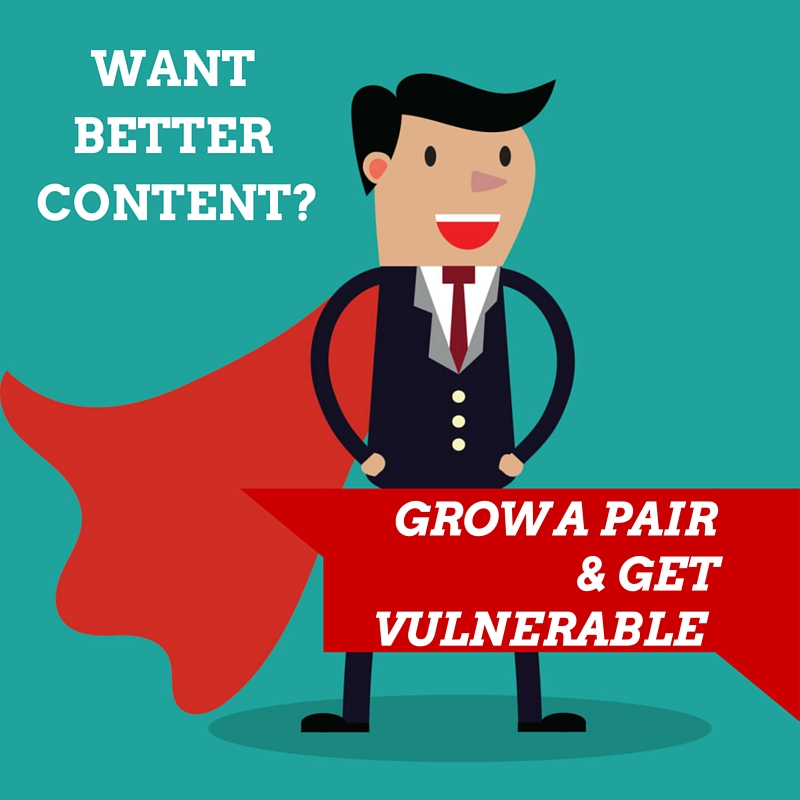Want better content? Grow a pair and get vulnerable
Great speakers make you feel like their message is pointed directly at you. Having had the pleasure to listen to Dr. Brené Brown’s keynote at HubSpot’s INBOUND15 conference this year had that effect on me. If you don’t know who she is (how did I miss this genius with three New York Times best sellers right now?!?), she gave one of the most viewed TED Talks, changed lives, and is well on her way to changing
mine.
In fact, the weekend we got back from Boston, I had to drive a few hours to pick up my pup and listened to podcast interviews with her the whole way. I couldn’t get enough of her insights on vulnerability and shame (and parenting, even though I parco acquatico gonfiabile only have a furbaby). I’ve also moved her book, Daring Greatly, to the top of my reading list (sorry, George R. R. Martin).
There were so many Brenéisms flying around that I found myself (usually an avid notetaker), hanging on every word instead of clicking away on my MacBook. While this post would be an e-book if I delved into everything I got out of her keynote, I’ll share a few takeaways here on the importance of an often-repressed emotion: vulnerability.
In our culture, vulnerability is a sign of weakness. Never let ‘em see ya sweat. Boys don’t cry. We’ve been born and bred to put on a brave facade and keep on truckin.’ In reality, the opposite is what we should be doing, both in life and work.
News flash: you have no control over the outcome anyway, so go big
By its nature of being out in the world, your content is already vulnerable. As marketers, we have no influence over the outcome—whether it’s likes, shares, click-throughs, downloads, or even preventing some trolls from thinking they’re brave while anonymously bullying.
Flying comfortably under the radar may prevent some pushback or objections, but it will also keep glory well beyond reach. Brown encourages everyone to choose courage over comfort and dare greatly. This isn’t a one-and-done kind of thing. Daring greatly must be practiced daily. Here’s how:
- Choose courage over comfort. There is nothing comfortable about being brave. Innovation must come with courage, and it definitely has a get-your-ass-kicked guarantee. Know that trying will eventually end in failing. But it’s a better experience than sitting in the stands and never trying.
- Don’t “gold-plate” grit. Real failure can take your breath away. Don’t repress it. Have open convos about how failure feels. Let it out and make room for your next big victory.
- Turn failure into future success. Being willing to fail requires being open. Use that same openness to learn from failure instead of beating yourself up over it. We do this as marketers analyzing, testing—even throwing the whole thing out and starting over.
- Be aware of when you’re emotionally snared. Don’t get so caught up in your imaginary bullshit you spend all your energy on fabricated scenarios. If you’re like me, you spend WAY too much time in your head, letting your imagination run amuck and your emotions follow. One way to shut it down is to create a “shitty first draft” or SFD, then writing it down or sharing it as a means to shut it down. Where vulnerability comes in is when you think you’ve been slighted and you immediately address it with the other person, instead of allowing your shitty first draft to become your reality. The same can apply for fear of failure. Get the SFD out of your system and dare greatly.
Do you really need to be vulnerable with your content?
It’s so cozy in Mediocreville, so why risk it?
Well, for starters, 76 percent of B2B organizations plan on producing more content in 2016. And at that rate, safe content will face the same fate as banner ads, print ads and commercials — an audience that’s totally immune to all the time and effort that went into creating it.
Another great INBOUND15 speaker I had the pleasure of learning from for a second time, MarketingProfs’ Ann Handley puts it like this: “The biggest missed opportunity in content is playing it too safe.”
Sooner or later we all need to accept the fact that not everyone is going to like us. Same goes for our brand. Is it better to be somewhere in the middle with yawn-inspiring blog posts and pseudo-insights, or to stand for something knowing some people will turn away?
You need hearts, brains and guts to stand out. We are only scratching the surface of this topic here, stay tuned for follow-up posts that dig a little deeper into the how of growing a pair with your tone, your content and your life (and how we’re going balls out with our holiday card this year).
Have you stepped out of your comfort zone with your content? Please share your story in the comments.









